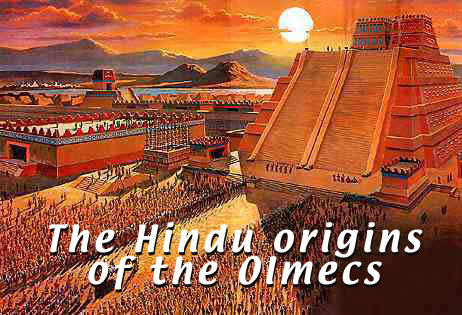
THE OLMEC - HINDU CONNECTION
by Gene Matlock
Mike Chrometer writes:
Michael Xu, who teaches Chinese studies at Texas Christian University,
reports finding artistic motifs on 3,000-year-old artifacts from the Olmec
culture in southern Mexico that are identical to Chinese inscriptions from
the Shang Dynasty, which dates to the same era.
Xu has studied hundreds of drawings on tortoise shells and animal shoulder blades that have been kept for decades in American museums and largely ignored. And he reports, "When I first brought my artifacts from the Americas to China, scholars there thought that I just had more examples of Shang writing." Xu says that Olmec and Shang dynasty symbols for sun, sky, trees, water, rain, astronomy, sacrifice and religion are so close they can't be accidental. Furthermore, he has found that the symbols occur in the same sequences in both cultures. There are several dozen examples of these, which means the symbols can be read as sentences -- the same sentences with the same meanings in China and in Mexico. This style of writing, called "jiaguwen," the oldest Chinese characters, existed in Asia for about 600 years, until about 1,000 B.C. Xu dates the similar writing in Mesoamerica at about 1,100 B.C. What's significant, Xu notes, is that the Olmecs are regarded as the first civilization, the mother culture of the hemisphere, appearing 1,000 years before the Mayans and with no antecedents. "It seems like those people came out of the sky," says Xu. "Overnight they knew how to use jade, damasks. They had astrology, astronomy." In particular, he said they had artistic motifs on jade bars, called "jade celts," that were used as ritual objects and to identify the rankings of their leaders. "You cannot find jade celts anywhere else in the world except ancient China and Mesoamerican sites. Nobody else used jade for ritual objects, for burial, especially wrapped up in cinnabar, the red powder, except in these two places." There is the legend in China, says Xu, that when the Shang dynasty collapsed, replaced by the Zhou dynasty, some 250,000 people were displaced and disappeared. "I don't think 250,000 people came to America," says Xu. "But some made it. How many does it need to spread the gospel? Maybe only a dozen; look at missionaries today. Scholars ask, where is the bronze, where is this, where is that? Look at the Mayflower people from Europe. Did they bring palace things? They did not. They mostly just brought themselves. |
Back to Viewzone || Back to Olmec Article || Add Comments